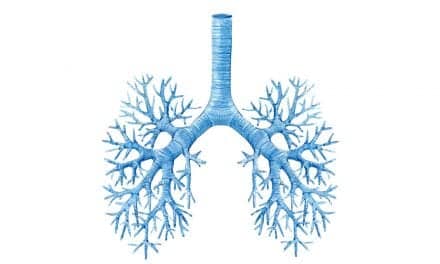Jaber Hassan, MD, of the Blount Memorial Sleep Health Center, says that recent advances in noninvasive ventilator support using BPAP or BiPAP systems have notably decreased patients’ with chronic obstructive pulmonary disease (COPD) chances of needing an invasive ventilator.
A news release from Blount Memorial Hospital indicates that sleep apnea patients typically use a CPAP system to aid breathing at night, and Hassan says these devices are making advances with patients whose respiratory failure is a result of COPD.
Hassan states, “People with severe COPD still can live long, decent lives, providing that their health care is maximized. Still, they’re prone to life-threatening flare-ups that often can require hospitalization and mechanical ventilation to help them recover.” BPAP or BiPAP systems use a mask to deliver air pressure instead of requiring a tube to be placed in the trachea. These systems are very similar to a CPAP, which has shortened hospitals stays, has helped prevent the overall deterioration of quality of life, and reduced the costs incurred with using a ventilator, according to Hassan.
Hassan explains that BPAP systems help rest the breathing muscles of patients at night, and “with the right patient, the use of a BPAP machine at night can improve carbon dioxide and oxygen levels during the day on a chronic basis.” Hassan states, “Much of the evidence for the BPAP’s effectiveness was speculative until a study released this fall in The Lancet journal found that patients with severe COPD and high carbon dioxide levels had a remarkable drop in mortality rates and an improved overall quality of life.”
He believes the results of the study will have a very positive impact on COPD treatments and the positive effect is expected to be more pronounced in patients with sleep apnea and COPD.
Hassan expects COPD will continue to be a disease on the rise. Hassan declares, “Baby boomers that have developed severe COPD are becoming a major challenge due to frequent hospitalizations, the increasing costs of medicine and the drop in quality of life they experience.” He adds, “However, with careful monitoring, maximization of care, vaccination, screening for sleep apnea and consideration of home BPAP systems when appropriate, we potentially can make remarkable reductions in the effects of COPD.”
Source: Blount Memorial Hospital











As a homecare provider who specializes in management of ventilation for all patients with chronic respiratory failure, I could not agree more. We see tremendous results with our COPD patients and get amazing feedback from those patients who are regularly compliant with NIV treatment programs. I would add a correction to this article, however. We no longer use BiPAP devices for this patient group. Non-invasive ventilators are the therapy of choice here in our region now and, although these are applied to the patient in the same manner as a CPAP or BiPAP (as stated), they are NOT BiPAPS! Volume targeted ventilation is essential to proper management of the respiratory failure patients at home, just as it is in the acute care setting. Patients who use these devices are also provided with on-going clinical follow up for the duration of time they are on this therapy, unlike when they receive a BiPAP. These are clinical respiratory devices and BiPAPs are merely sold to the patient and no further clinical support is offered after the purchase. Use caution with who you choose to deliver these devices as they are more complex and require strong clinician input at the point of service (home) to ensure success. With the right provider, the benefits are clear.
Hi Chris I am in urgent need of some advice. My brother who is 59 was just admitted to the hospital with respiratory failure due to COPD. They had him on a BiPap for about 4 days because his CO2 levels were so high. Basically he and we were told that he was dying and to prepare to go to a palliative stage. He is fighting hard and does not want to die, and he has recently come off the BiPap during the day and is showing some signs of stabilization – he is lucid and struggling to talk and is developing an appetite again. The doctor says his lungs are too damaged (large buli) to be intubated. Do you have any advice? Please respond to my personal email as well: [email protected]
Thanks for your help
Hi mr.Chris !!! My dad 60yrs old in the last stage of COPD , he is in and out the hospital a lot !!!! Doctor prescribed him a Bipap machine for everyday home using , because he is living out side of U.S so I have no choice but buying the Bipap machine instead renting them !!! Anyway , he has been using it for 2 yrs now , but he said he feel less and less air on the machine now !!! I wonder because his COPD getting worse so he need a better one than the one he has right now !!! We brought the question to the doctor over there but it seems the doctor can’t give us any good answer because he don’t know much about home using Bipap machine on the market !!! As a home care provider !!! Could you please let me know is there any better or stronger machine that I can upgrade for my dad’s need ??? Now he is using Respironics System One BIPAP Auto SV Advanced !!! According to the topic , what is the difference between Non-invasive ventilator vs. Bipap ??? Any advice would be a valuable info for my dad’s situation !!! I greatly appreciate !!!
I’m really sorry that I’m responding to this I realized very late but maybe it may still help for 1 the BiPAP is two machines in one it’s pretty much the best non-invasive machine you can get it splits in half you put water in it because it also has a humidifier with warm up the air that you breathe in at night or whenever in use and there’s different levels and the air flow is not good enough speak with your doctor or a sleep apnea technician and they can turn it up for you however if it’s comfortable I hope that helps
Hello!
My father is 78 and has COPD quite severe as he has been hospitalized twice in the past 2 months with extremely high CO2 levels requiring a hospital BiPap device to reduce. We live in Canada, is there any place or person that you can recommend we contact to enquire about a BPap device for home use? He does have an apt in September with a respiratory doctor and I would like to be prepared to discuss. thanks!
The person who answered your question didn’t reply to you directly but commented after you. So you will have to return to this site to see the answer. Good luck!
Yo need to talk to a polynologeist that is he I acquired my bi pap I have also got extreme copd
How does it help COPD?
Thank You,
Mary
Hi,
Many thanks for this article and it’s really helpful. My mother is 76 years old having severe pulmonary artery hypertension and poor functioning lungs resulting in COPD. Her Blood C02 level often goes quite high and normally does not want to come down below 60%. She gets hospitalized with invasive ventilation or BiPap quite often. Just wondering whether keeping a Bipap at home and using it everyday night will help. While we will definitely consult a physician but any alternate advice will help. I am also getting confused between different types of BiPaps. Some are Auto and some are S/T etc. What’s the difference? I would also like to know whether I will have to buy an oxygen concentrator as well. Will be grateful for any help and advice.
i have severe emphysema and was admitted twice into hospital on discharge i was supplied with a bipap machine and nebuliser which has helped greatly
I’m 56 with chronic COPD. Recently the work being done by mtnce in the area after a hurricane totally exacerbated my condition and I went into the hospital thinking for sure I would have to be intibated! That BIPAP machine saved me totally from it! I quit smoking the week before, vowing never to use another! And I feel better now than I have in years!
Sorry my email was incorrect. See correct email here: [email protected] Hi Chris I am in urgent need of some advice. My brother who is 59 was just admitted to the hospital with respiratory failure due to COPD. They had him on a BiPap for about 4 days because his CO2 levels were so high. Basically he and we were told that he was dying and to prepare to go to a palliative stage. He is fighting hard and does not want to die, and he has recently come off the BiPap during the day and is showing some signs of stabilization – he is lucid and struggling to talk and is developing an appetite again. The doctor says his lungs are too damaged (large buli) to be intubated. Do you have any advice? Please respond to my personal email as well: [email protected]
Thanks for your help
Dear Sir/Madam
my dad has been COPD for 4 years, he used to go in and out hospital for many times since 5 months ago. His doctor recommended to use Bipap but he does not say which bipap Make and mode will be the best. I consider to use Phillips Respironice Pro/ Aucto and S/T. The provider said, Phillips bipap S/T is the best one due to
it includes S and T but the price is quite high,
Coulde you please give me some advise
thanks